Birds are fascinating creatures that come in all shapes and sizes, and today, we are going to take a closer look at a unique species, the Hawaiian Goose or Nene. The Hawaiian Goose is a remarkable bird with an exciting history, intriguing facts, specific size, preferred habitat, and a classified group, making it a topic worth exploring.
Firstly, let’s delve into the history of the Hawaiian Goose. Also known as Nene, this species is native to the Hawaiian Islands and holds a special place in the hearts of locals. It is believed to have arrived in Hawaii approximately 500,000 years ago, making it one of the oldest geese in the world. The Nene is also the official state bird of Hawaii, highlighting its cultural significance.
Now, let’s uncover some intriguing facts about the Nene. This goose stands out among its feathered friends with its distinct features, including a black head, buff-coloured cheeks, and white neck. It is a medium-sized bird, reaching an average height of 16-18 inches and weighing around 3-6 pounds. Unlike most geese that migrate, the Nene prefers to stay on the islands all year round. They are herbivores, feeding on grasses, leaves, and seeds.
Regarding habitat, the Nene can be found in various locations across Hawaii, including grasslands, shrublands, lava fields, and coastal areas. These birds enjoy nesting in sheltered spots like rocky crevices or under vegetation. Unfortunately, due to habitat loss and introduced predators, the Nene is considered an endangered species today, emphasizing the importance of conservation efforts.
The Hawaiian Goose or Nene is an intriguing bird with a rich history, unique features, specific size, favoured habitat, and a special place in Hawaiian culture. By understanding and appreciating these creatures, we can work towards their conservation and ensure their existence for future generations. Remember, there are countless remarkable animals out there, and our blog already covers an extensive range of over 155 animal species to satisfy your curiosity further. So, let’s dive into the beautiful world of birds and explore the fascinating life of the Hawaiian Goose and many more.
History of Hawaiian Goose (Nene)

The Hawaiian goose, also known as the Nene, has a fascinating history. It is the state bird of Hawaii and is found nowhere else in the world. The story of the Nene began thousands of years ago when it migrated from North America to the Hawaiian Islands.
When the first Polynesians arrived in Hawaii, they brought animals and plants they needed for survival. Unfortunately, these new species caused the Nene population to decline. The arrival of European settlers also led to further threats, such as hunting and the destruction of their habitat.
By the 1950s, only about 30 Nene were left in the wild, making them one of the rarest birds in the world. However, their numbers slowly started to recover thanks to dedicated conservation efforts. Scientists worked to protect their natural habitat and set up captive breeding programs. These programs were successful, and today, there are over 2,000 Nene in the wild.
The Nene is a remarkable bird because it symbolizes the uniqueness and fragility of Hawaii’s natural environment. It serves as a reminder that every species, no matter how small, plays a vital role in maintaining the balance of our ecosystems. By learning about and appreciating the history of the Nene, we can better understand the importance of protecting endangered species and preserving our planet for future generations.
Importance of Hawaiian Goose (Nene)

The Hawaiian Goose, also known as Nene, is a unique bird that is very important. Here are three reasons why the Nene bird is so essential. Firstly, the Nene bird is crucial because it symbolises Hawaii. It is the state bird of Hawaii and is found nowhere else in the world. This means that the Nene bird is unique and represents the beautiful islands of Hawaii. People in Hawaii love the Nene bird and see it as a part of their identity.
Secondly, the Nene bird plays a big role in the ecosystem. It eats plants and helps to spread seeds around, which helps new plants grow. Without the Nene bird, the plants in Hawaii may not be able to grow as much. This can affect other animals that depend on these plants for food and shelter. Lastly, the Nene bird is important for conservation efforts. Conservation means protecting and taking care of animals and their habitats.
The Nene bird was once in danger of becoming extinct, but thanks to efforts from people, its population is slowly growing. By protecting the Nene bird, we are helping preserve Hawaii’s natural beauty and ensuring that future generations can enjoy seeing this special bird. The Hawaiian Goose, or Nene, is an important bird for many reasons. It symbolises Hawaii, plays a role in the ecosystem, and is part of conservation efforts.
Amazing Facts About Hawaiian Goose (Nene)
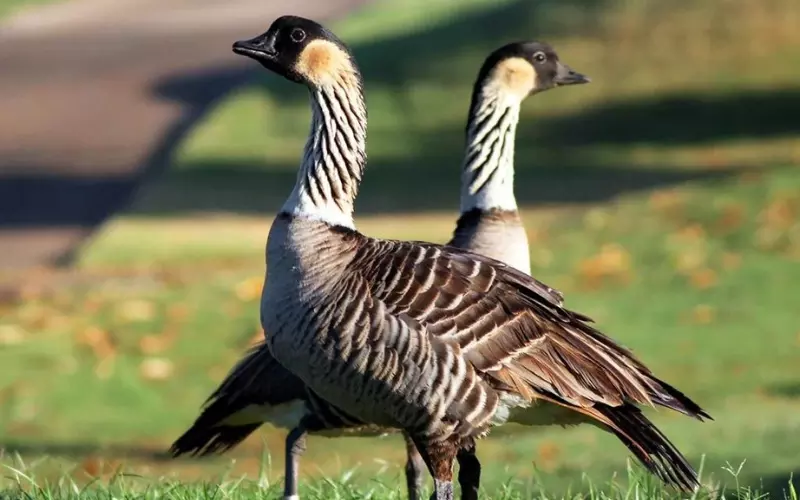
1. The Hawaiian Goose, also known as the Nene bird, is the official state bird of Hawaii.
2. Nene birds are typically 22-27 inches long and weigh around 3.5 to 6.5 pounds.
3. These birds have a distinctive appearance with grey-brown plumage, a black head, and white cheek patches.
4. Nene birds have adapted to various habitats, including grasslands, lava plains, and coastal areas.
5. They are the world’s rarest goose species and are listed as endangered.
6. Nene birds are primarily herbivores, feeding on grasses, leaves, flowers, and occasionally insects.
7. During the breeding season, Nene birds build nests on the ground and lay 2-5 eggs at a time.
8. Both male and female Nene birds take turns incubating the eggs, which hatch after about 30 days.
9. Nene birds are known to be monogamous and mate for life, forming strong bonds with their partners.
10. These birds are excellent flyers, capable of long-distance flights and reaching up to 40 miles per hour.
11. Nene birds communicate through various calls, including honking sounds and soft clucks to express emotions.
12. Hunting and habitat loss have been the primary reasons for the decline in Nene bird populations.
13. Conservation efforts, such as captive breeding programs and habitat restoration, have helped increase the number of Nene birds in the wild.
14. Nene birds have few natural predators in Hawaii, with mongoose and feral cats being their main threats.
15. Tourists visiting Hawaii can often see and learn about Nene birds in national parks, wildlife refuges, or designated protected areas.
Can we keep Hawaiian Goose (Nene) as our Pet?

The Hawaiian Goose, also known as the Nene, is a beautiful bird native to the Hawaiian Islands. In the past, some people used to keep them as pets, but it is no longer allowed. The Nene is a protected species, meaning keeping them as pets is illegal and harmful. This law was put into place to help preserve the population of these unique birds in their natural habitat.
Unfortunately, the Nene bird is currently facing the threat of extinction. Due to habitat loss, hunting, and predators introduced by humans, the Nene population has drastically decreased over the years. This has led to serious concerns about their survival. Therefore, we mustn’t keep them as pets, as this would further disrupt their already fragile population.
It is essential to understand that wild animals, including the Nene bird, belong in their natural habitats. They have specific needs and play essential roles in the balance of our ecosystems. Our responsibility is to protect and conserve them rather than keep them as pets for our enjoyment. By respecting their natural environment and supporting conservation efforts, we can help ensure the future existence of the magnificent Hawaiian Goose, the Nene.
Size of Hawaiian Goose (Nene)

The Hawaiian goose, also known as the Nene bird, is a unique and special bird native to the Hawaiian Islands. It is a medium-sized goose, measuring about 24 to 28 inches long and weighing around 3 to 5 pounds. Compared to most geese, the Nene is smaller in size.
The Nene bird has a slender body, long neck, and black bill. Its feathers are predominantly grey with black and white markings. It has short wings that allow it to fly, but it prefers to walk or run on land.
Due to its smaller size, the Nene bird is easily recognized among other geese. It is the smallest goose species that is found in the Hawaiian Islands. Despite its more diminutive stature, the Nene bird is an excellent survivor and adapts well to its environment. It has strong legs that enable it to walk on rough and uneven terrains, such as volcanic rocks.
The Hawaiian goose, also known as the Nene bird, is a medium-sized goose that measures around 24 to 28 inches and weighs about 3 to 5 pounds. Its smaller size compared to other geese differentiates it from the rest. The Nene bird stands out among its larger counterparts with its slender body, long neck, and unique grey-coloured feathers.
Habitat of Hawaiian Goose (Nene)

The Hawaiian Goose, also known as the Nene bird, lives in the beautiful islands of Hawaii. These unique birds like to make their homes in different island habitats. They can be found in places like lava fields, shrubby areas, grasslands, and near water sources like ponds or marshes. The Nene birds are adaptable and can live in various habitats.
One of the favourite habitats for the Nene bird is the lava fields. In Hawaii, there are many volcanic areas where the ground is made up of hard lava rocks, and little vegetation grows. Surprisingly, the Nene birds are fond of these lava fields and feel at home in the rough terrain. They make their nests in crevices and holes in the rocks, protecting them from predators.
Another habitat where the Nene bird can be found is in shrubby areas. These areas have low-lying bushes and small trees, providing good bird cover. The Nene birds blend in well with the shrubs, making hiding from predators easier. Here, they build their nests on the ground and lay their eggs in a safe place.
Lastly, the Nene bird also likes to live near water sources like ponds or marshes. These areas provide the birds with a good supply of water and food. The Nene birds feed on grasses growing near the water, and they often swim in the ponds to cool off during hot days. The water sources also attract other birds and animals, making it a lively and vibrant habitat for the Nene birds.
To sum up, the Hawaiian Goose or Nene bird is well adapted to its various habitats in Hawaii. It can live in lava fields, shrubby areas, and nearby ponds or marshes. The Nene birds are smart and can make their nests in safe places where they have protection from predators. Their ability to live in different habitats is one of the reasons they have survived and thrived in Hawaii’s unique environment.
Evolution of Hawaiian Goose (Nene)
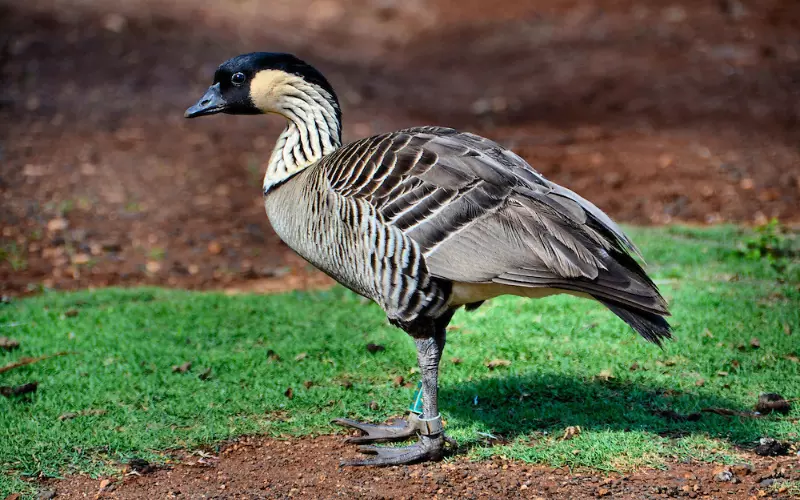
The Hawaiian goose, known as the Nene bird, has a fascinating evolution showcasing its unique journey. It is believed that the ancestors of the Nene bird arrived from North America thousands of years ago. These early geese somehow went to Hawaii, which became their new home. Over time, the harsh conditions and limited resources on the islands led to changes in the appearance and behaviour of these birds.
As the Nene adapted to their new habitat, they developed several physical traits that helped them survive. One of the most noticeable features is their strong, sturdy legs that allow them to navigate the rugged terrain of Hawaii. They also have shorter wings compared to other geese, which helps them manoeuvre through forests rather than fly long distances. These adaptations show how the Nene bird has evolved to thrive in the Hawaiian environment.
Another exciting aspect of the Nene’s evolution is their feeding habits. Unlike other geese that mainly eat grass, the Nene has evolved to survive on various plants found in Hawaii. They have developed specialized beaks to eat seeds, berries, and leaves. This adaptation has allowed the Nene to find food despite scarce resources, making them well-suited to their island home.
The Hawaiian goose, or Nene bird, has undergone significant changes for thousands of years since its arrival in Hawaii. With strong legs and shorter wings, they have adapted to the challenging terrain of the islands. Their beaks have also evolved to eat a diverse range of plants, ensuring their survival even in times of scarcity. The evolution of the Nene bird is a remarkable example of how animals can adapt and thrive in different environments.
Classification of Hawaiian Goose (Nene)

The Hawaiian goose, also known as the Nene bird, belongs to the animal classification called Aves. Aves is a class that includes all types of birds. The Nene bird is a special type of goose found only in the beautiful islands of Hawaii.
Within the classification of Aves, the Nene bird belongs to the family Anatidae. This family includes other water birds like ducks and swans. The Nene bird is a unique member of this family because it is the only goose species that lives in the Hawaiian Islands.
The scientific name for the Nene bird is Branta sandvicensis. The genus name Branta refers to the group of birds that are geese, while the specific name Sandvicensis refers to its connection to the Hawaiian Islands, which were once known as the Sandwich Islands.
The Nene bird is a protected species in Hawaii because it is endangered. This means that very few of these birds are left in the world, and they need to be preserved. Efforts are being made to protect their habitats and control their threats, such as predators and loss of food sources. By understanding the classification of the Nene bird and its unique qualities, we can appreciate the importance of preserving this beautiful species for future generations.
Overall, the Hawaiian goose, or Nene bird, is a unique member of the bird family called Anatidae. It stands out because it is the only species of goose found in the Hawaiian Islands. With its scientific name, Branta sandvicensis, the Nene bird is a treasured and protected species. Our responsibility is to ensure its survival in its natural habitat by valuing and protecting this unique species.
Different Types of Hawaiian Goose (Nene)

1. Nene (Hawaiian goose) – The State bird of Hawaii, the Nene, is a small goose that is native to the Hawaiian Islands. They have a distinct appearance with their brownish-grey feathers, blackheads, and curious red-orange beaks.
2. Endemic species – The Nene is an endemic species which is found naturally only in Hawaii. They are not found anywhere else in the world. This makes them truly unique and a special part of Hawaii’s natural heritage.
3. Conservation success – The Nene was once on the brink of extinction due to hunting and habitat loss. However, their population has rebounded through successful conservation efforts and is no longer considered critically endangered.
4. Adaptation – Nene birds have adapted to the Hawaiian environment. Unlike other geese, they have shorter wings, which allow them to manoeuvre through the dense vegetation and rocky terrain of the lava fields in Hawaii.
5. Herbivorous diet – Nene geese primarily feed on grasses, seeds, leaves, and berries. Their diet is mainly herbivorous, so they do not eat meat. This makes them essential contributors to the ecosystem by controlling plant growth.
6. Breeding behaviour – Nene birds form pair bonds that last for life. They build their nests on the ground, usually in rocky areas, and both males and females help incubate the eggs and raise the young goslings.
7. Threats to survival – Despite the population recovery, Nene birds still face challenges. Habitat loss due to development and feral animals like mongooses, rats, and cats that prey on eggs and young goslings pose significant threats.
8. Tourism attraction – Nene birds have become popular for tourists visiting Hawaii. Many nature reserves and national parks offer opportunities for visitors to spot and observe these fascinating birds in their natural habitat.
9. Conservation efforts – Various organizations and initiatives are working towards the continued conservation of the Nene. These efforts include habitat protection, predator control, captive breeding programs, and public education to raise awareness about the importance of preserving this unique species.
10. Symbol of Hawaii – The Nene holds great cultural significance for the people of Hawaii. It represents the spirit of aloha, conservation, and the interconnectedness of humans and nature. It has become a symbol of the Hawaiian Islands and serves as a reminder of the beauty and fragility of our natural world.
Geographical Presence of Hawaiian Goose (Nene)

The Hawaiian Goose, also known as the Nene, is a special bird that can only be found in the beautiful islands of Hawaii in the United States. These geese have adapted to the unique environment of the Hawaiian archipelago and are well-suited to survive in this particular region. They have become a symbol of Hawaii and are highly cherished by the local community.
However, it is essential to note that the Hawaiian Goose is not found anywhere else. They are endemic to Hawaii, meaning they are only naturally found there and cannot be seen elsewhere. Their presence in the wild is limited to the islands of Kauai, Maui, Hawaii, Molokai, and Oahu.
Unfortunately, due to habitat destruction and hunting in the past, the Hawaiian Goose population dramatically decreased over the years. Today, conservation efforts are in place to protect and restore their habitats, allowing these beautiful birds to continue thriving in their natural environment. The Nene is now a federally protected species, and harming or disturbing them is prohibited.
The Hawaiian Goose, or Nene, is a one-of-a-kind bird species found exclusively in the stunning Hawaiian islands. You won’t find them anywhere else, as they are endemic to Hawaii. With dedicated efforts to preserve their habitat, these unique geese are being given a chance to keep gracing the Hawaiian skies and remain an important part of the islands’ rich natural heritage.
Scientific Name of Hawaiian Goose (Nene)
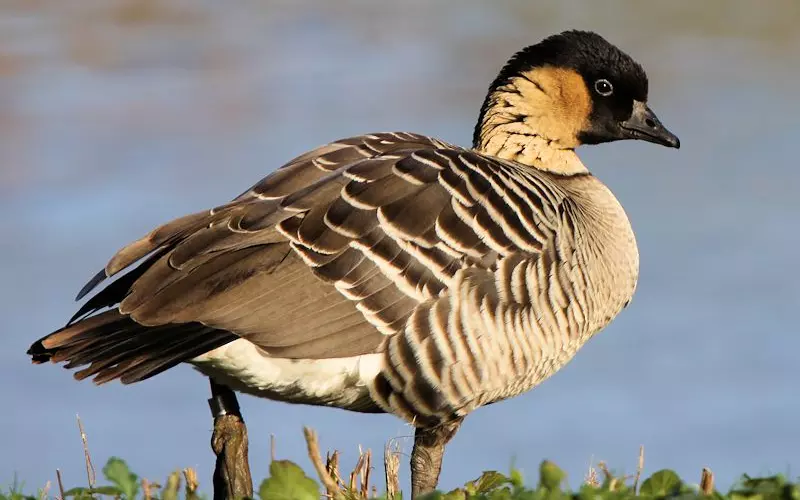
The scientific name of the Hawaiian goose, also known as the Nene, is Branta sandvicensis. The Hawaiian goose is a unique bird found only in the Hawaiian Islands. It is the official state bird of Hawaii and is considered a symbol of the islands’ wildlife.
The Nene is a medium-sized goose with a distinct appearance. It has a dark brown body, a white face, and a long, thin neck. Its legs are black, and its beak is black and slightly curved. Unlike other geese in wetland areas, the Nene prefers to live in dry volcanic slopes and high-altitude grasslands.
Due to habitat loss and human activities, the Hawaiian goose was once on the brink of extinction. However, thanks to conservation efforts, their population has gradually increased. Today, the Nene is protected by law and efforts are being made to restore its natural habitat.
The Hawaiian goose, or Nene, is a unique bird found only in Hawaii. Its scientific name is Branta sandvicensis, and it has distinctive features such as a dark brown body, white face, and long neck. Although it faced endangerment in the past, conservation efforts have helped the Nene population grow, ensuring this special bird’s survival.
Diet of Hawaiian Goose (Nene)
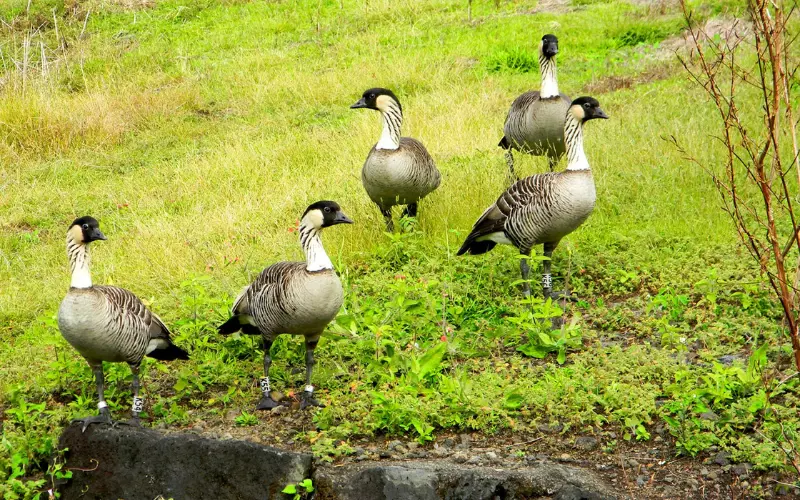
The Hawaiian Goose, also known as the Nene, has a unique diet essential for survival. These birds mainly feed on vegetation found in the volcanic slopes of Hawaii. They like to eat grasses, seeds, leaves, and flowers. These plants provide the Nene with the nutrients to stay healthy and strong.
A major part of the Nene’s diet consists of grasses. They graze on different types of grasses, such as Bermuda grass and Kikuyu grass. Grasses are a great source of energy for these birds. They use their sharp bills to pluck the grass and then swallow it.
Besides grass, the Nene also enjoys munching on seeds, leaves, and flowers. They eat seeds from various plants, including ferns and native shrubs. Leaves are an important part of their diet, too, especially when other food sources are scarce. The Nene also relishes the flowers of native plants, which provide them with essential nutrients.
To summarise, the Nene bird depends on a diverse diet to survive. Grasses form a significant portion of their meals, providing them with energy. They also eat seeds, leaves, and flowers from different plants. By consuming a variety of vegetation, the Nene is well-equipped to adapt to its natural habitat and sustain its population.
Locomotion of Hawaiian Goose (Nene)

The Hawaiian Goose, also known as the Nene bird, has a unique way of moving around. It waddles instead of walking or flying like other birds. This unique way of getting around is one of the reasons why it is so easy to spot them in their natural habitat.
When the Nene bird waddles, it moves with a funny side-to-side motion. It takes small steps with its short legs, which makes it look like it’s shaking its body as it walks. This distinctive locomotion helps the Nene bird navigate through different terrains, such as rocky areas or tall grass. Even though it may not be the fastest bird, its waddling gait allows it to keep a steady balance while moving.
The Hawaiian Goose, or Nene bird, has a distinct way of getting around – it waddles. This funny side-to-side motion helps them maintain balance and navigate various types of terrain. So, if you ever visit Hawaii, watch for the Nene bird waddling around!
Social and Sexual Behaviour of Hawaiian Goose (Nene)
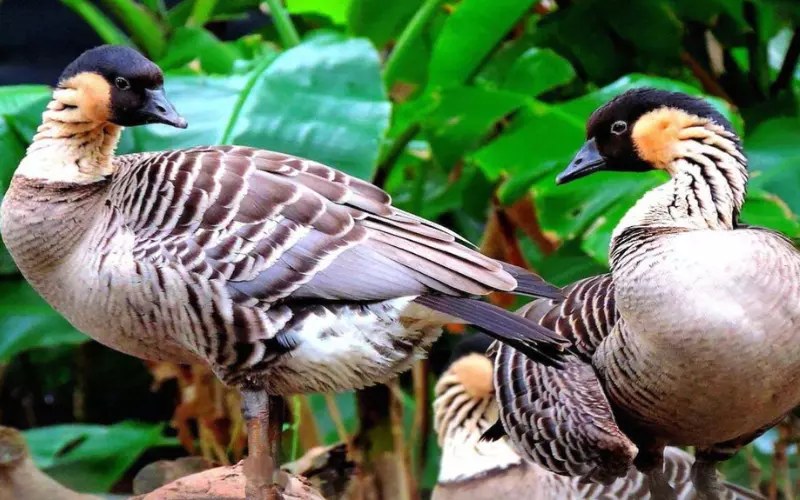
The Hawaiian Goose, also known as the Nene bird, has interesting social and sexual behaviour. These birds live in small groups called flocks, usually consisting of a breeding pair and their offspring. Flocks can have up to 15 birds. They communicate with each other through various calls and body language.
Regarding sexual behaviour, Nene birds form strong pair bonds for life. This means that once they find a mate, they stay together forever. They participate in courtship rituals where they stretch neck and call each other. This behaviour helps them bond and strengthen their relationship. After mating, the female lays an average of three to five eggs in a nest made of grass, feathers, and other materials.
The Nene bird’s social behaviour is also interesting. Within the flock, there is a clear hierarchy. The dominant pair gets to lead the group and make important decisions. Other members of the flock follow their lead. They also cooperate in various activities like foraging for food and protecting each other from predators.
The Hawaiian Goose, or Nene bird, has fascinating social and sexual behaviour. They form strong pair bonds for life, engage in courtship rituals, and live in flocks with a clear hierarchy. Observing their interactions and relationships can teach us the importance of cooperation and loyalty in nature.
Reproduction and Lifecycle of Hawaiian Goose (Nene)

The Hawaiian Goose, also known as the Nene bird, has a fascinating reproduction and life cycle. These birds usually mate for life, just like humans who have a partner forever. They build their nests on the ground using materials like grass and leaves. The female Nene will lay about two to five eggs and then take turns with the male to warm the eggs. This is called incubation, and it takes about a month for the eggs to hatch.
Once the adorable Nene chicks emerge from their eggs, they are covered with soft feathers. The parents take great care of their little ones, feeding and protecting them. The chicks grow quickly and can leave the nest after only a day or two. But don’t worry, they are not alone! Their parents watch over them as they explore their surroundings and learn how to find food.
As the Nene chicks grow, they go through different stages of life. They start with fluffy feathers, but they are soon replaced by mature ones. The Nene bird’s diet mainly consists of grass and seeds found on the ground. They are also excellent swimmers and can fly, even though they prefer to walk most of the time.
With time, the Nene birds become adults ready to have their own families. They find a partner, build a nest, and continue the cycle by laying more eggs. And so, the unique life cycle of the Nene bird continues, ensuring that these unique Hawaiian geese keep thriving for future generations to enjoy.
Threats to Hawaiian Goose (Nene)
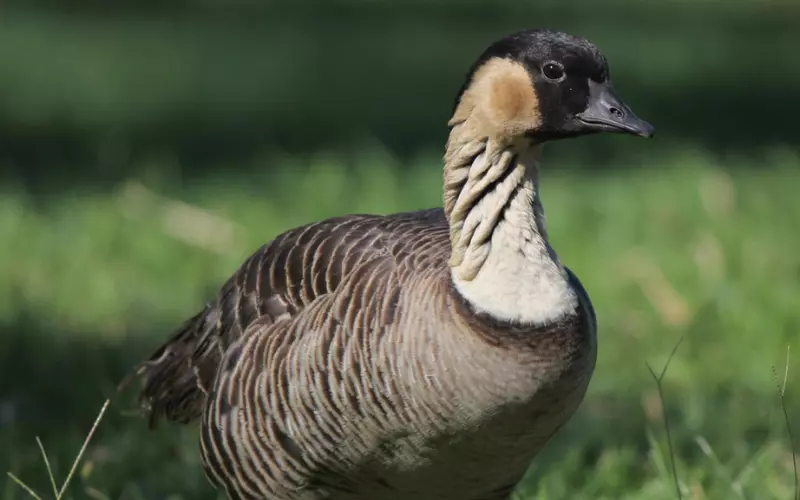
The Hawaiian Goose, also known as the Nene, is a special bird native to the beautiful islands of Hawaii. However, several threats pose a danger to the survival of this unique species.
One major threat to the Nene bird is habitat loss. As more and more people move to Hawaii and land is developed for cities, buildings, and agriculture, the natural habitats of the Nene are being destroyed. This leaves the Nene with less space to live, find food, and raise their young.
Another threat to the Nene is the presence of non-native predators. Some animals, such as dogs, cats, and mongoose, were introduced to Hawaii by humans. Unfortunately, these predators see the Nene as a potential meal. They hunt the birds and their eggs, greatly reducing the Nene population.
Lastly, human activities also pose a threat to the Nene. Sometimes, people harm the Nene unintentionally. For example, cars driving on roads near the birds’ habitats may accidentally hit them. Additionally, some people may even intentionally disturb or harm the Nene out of ignorance or cruelty.
We must take action to protect the Nene bird and ensure its survival. This includes preserving and restoring their habitats, keeping non-native predators away from their populations, and educating people about the importance of this unique species. Working together can make a difference and help the Hawaiian Goose thrive for generations.
Population of Hawaiian Goose (Nene)
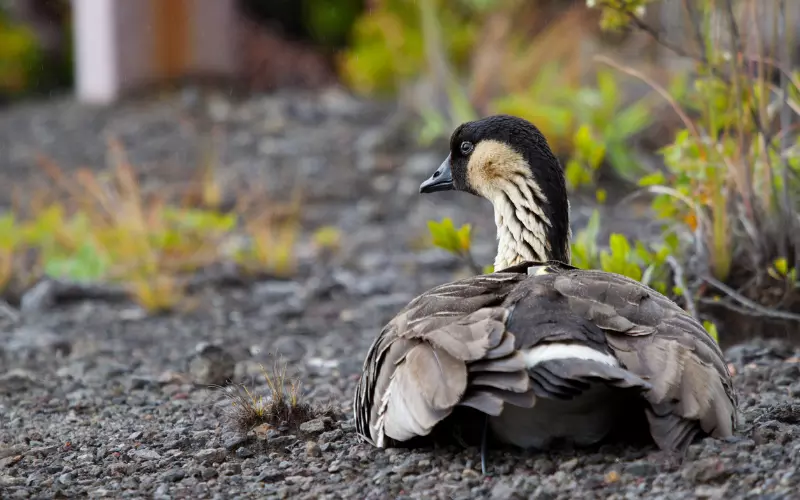
The population of the Hawaiian Goose bird, also known as the Nene, was once in danger of becoming extinct. Experts estimated that only 30 individuals were in the wild in the 1950s. Thankfully, their numbers have increased through conservation efforts, and they are no longer considered critically endangered.
Today, the assumed figure for the population of the Nene is much higher. It is estimated that there are now around 2,500 individuals living in the wild. This increase is due to the hard work of scientists, conservationists, and local communities who have worked together to protect the birds and their habitats. The Hawaiian Goose is considered a success story in conservation efforts.
However, not all animals are as fortunate as the Nene bird. Some species have become extinct, meaning they no longer exist anywhere on Earth. Extinction can happen for many reasons, such as habitat loss, hunting, or environmental changes. We need to understand the impact of our actions on the natural world and work towards conserving and protecting endangered species before it’s too late.
Conclusion
The fascinating Hawaiian Goose, known as the Nene bird, has a rich history and unique characteristics. This beautiful bird is endemic to Hawaii and is vital to Hawaiian culture. The Nene has faced numerous threats, including habitat loss and invasive species, but efforts have been made to protect and conserve this endangered species.
The Nene is a small goose with a distinctive appearance and behaviour. It has a black head, brown body, and cream-coloured cheeks. Unlike other geese, the Nene is not well-adapted for swimming and prefers to be on land. It is well-known for its honking sound, which is used to communicate with other Nene birds.
The habitat of the Nene is mainly found in the higher elevation regions of Hawaii, such as volcanic slopes and grasslands. These areas provide an ideal environment for the Nene to forage for food, including grass, leaves, and seeds. It is crucial to protect and preserve these habitats to ensure the continued survival of the Nene and other native Hawaiian species.
The Hawaiian Goose, or Nene bird, is a remarkable creature with a unique history and features. Despite being endangered, efforts are being made to conserve their population and protect their habitats. The Nene plays a significant role in the Hawaiian culture and reminds us of the importance of preserving our natural world and its diverse inhabitants. Let us continue to work together to ensure the survival of the Nene and other animals like it.
Frequently Asked Questions about Hawaiian Goose (Nene) (FAQ’s)
What is the Hawaiian Goose bird?
The Hawaiian Goose, also known as the Nene, is a species of bird native to the Hawaiian Islands.
Why is the Hawaiian Goose bird also called Nene?
The name “Nene” comes from the bird’s call, which sounds like “nay-nay.”
How did the Hawaiian Goose get its scientific name?
The scientific name for the Hawaiian Goose is Branta sandvicensis. The specific epithet “sandvicensis” refers to the former name of the Hawaiian Islands, the Sandwich Islands.
Is the Hawaiian Goose endemic to Hawaii?
Yes, the Hawaiian Goose is endemic to the Hawaiian Islands, meaning it is found nowhere else in the world.
What is the size of a Hawaiian Goose?
The Hawaiian Goose is a medium-sized goose, with adults typically measuring around 22-27 inches (56-69 cm) in length.
What does the Hawaiian Goose look like?
The Nene has a distinctive appearance, with mostly brown plumage, black head, and white cheeks.
Is the Hawaiian Goose flightless?
No, the Hawaiian Goose is not flightless. It is capable of flying but tends to spend most of its time on the ground.
What is the diet of the Hawaiian Goose?
The Nene primarily feeds on grasses and leaves but may also consume seeds, berries, and insects.
Are Hawaiian Geese social birds?
Yes, Hawaiian Geese are social birds that often live in small flocks or family groups.
Where do Hawaiian Geese nest?
Hawaiian Geese build their nests on the ground, usually in secluded areas with tall vegetation.
How many eggs does a Hawaiian Goose typically lay?
A female Hawaiian Goose will usually lay a clutch of 2 to 5 eggs.
Why is the Hawaiian Goose considered endangered?
The Hawaiian Goose population dramatically declined due to habitat loss, predation by introduced predators, and hunting. These factors have led to the Nene being classified as endangered.
What conservation efforts are being made to protect the Hawaiian Goose?
Various conservation efforts, including habitat restoration, captive breeding programs, and predator control, are being implemented to protect the Hawaiian Goose.
How many mature Hawaiian Geese are estimated to be in the wild today?
It is estimated that there are around 2,000 mature Hawaiian Geese in the wild currently.
Are there any cultural or symbolic meanings associated with the Hawaiian Goose?
Yes, the Hawaiian Goose is considered a symbol of the state of Hawaii and holds cultural significance in Hawaiian mythology as a guardian spirit.
Can the Hawaiian Goose be kept as a pet?
No, it is illegal to keep a Hawaiian Goose as a pet due to their endangered status and the need to protect their populations in the wild.

Hey there, I’m Kristen Haudenschild! I’m like a superhero for animals and people.
I work as a Dependable Hard Working Supervisor, which means I help both people and animals grow and learn. I did my school at OdySea Aquarium and Georgia Southern University in Tempe, Arizona. That’s where I learned all about animals, and guess what? I’m fascinated by them!
I even write cool articles about animals. My job history includes being an Animal Trainer and a Marine Mammal Trainer II at OdySea Aquarium. I’ve also been a Senior Animal Care Specialist and an Animal Care Specialist 2.
I love exploring animals and am always ready to help others learn more about them. So, if you ever need info about animals, give me a shout!












